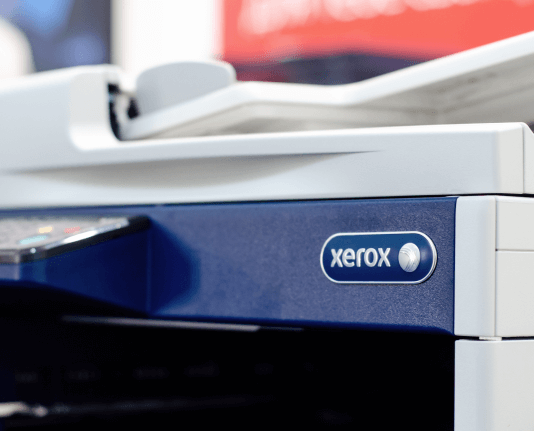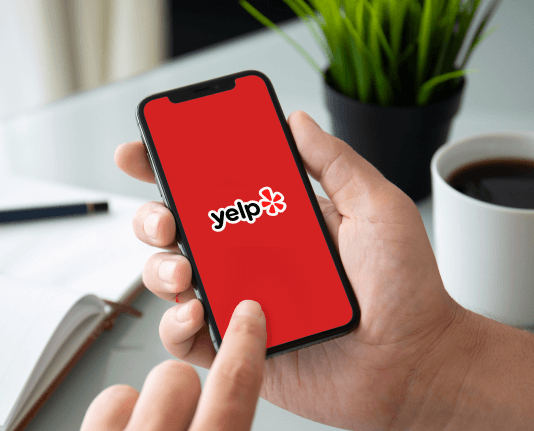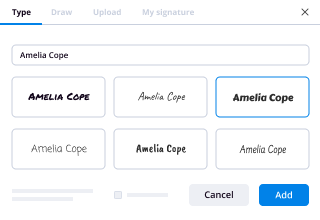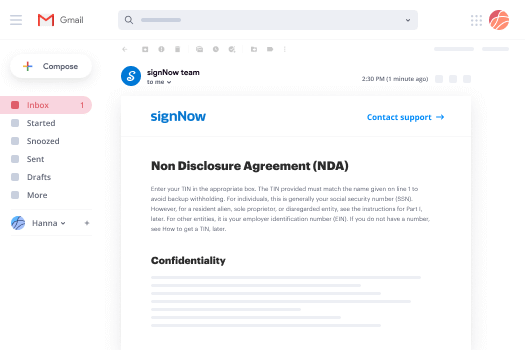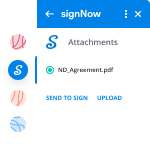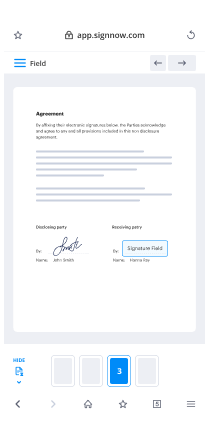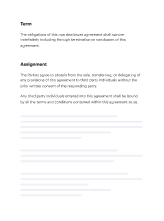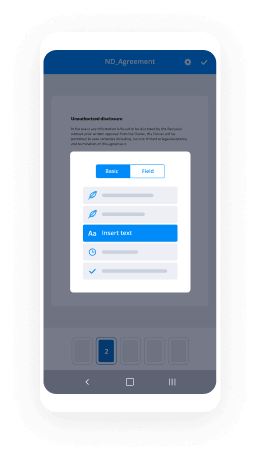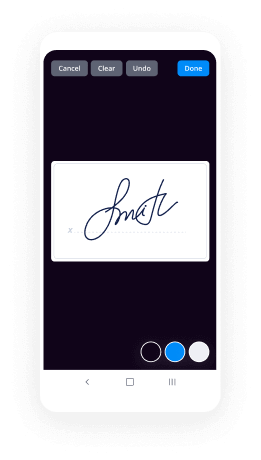How To Use eSign in 1Password
Contact Sales
Make the most out of your eSignature workflows with airSlate SignNow
Extensive suite of eSignature tools
Discover the easiest way to Use eSign in 1Password with our powerful tools that go beyond eSignature. Sign documents and collect data, signatures, and payments from other parties from a single solution.
Robust integration and API capabilities
Enable the airSlate SignNow API and supercharge your workspace systems with eSignature tools. Streamline data routing and record updates with out-of-the-box integrations.
Advanced security and compliance
Set up your eSignature workflows while staying compliant with major eSignature, data protection, and eCommerce laws. Use airSlate SignNow to make every interaction with a document secure and compliant.
Various collaboration tools
Make communication and interaction within your team more transparent and effective. Accomplish more with minimal efforts on your side and add value to the business.
Enjoyable and stress-free signing experience
Delight your partners and employees with a straightforward way of signing documents. Make document approval flexible and precise.
Extensive support
Explore a range of video tutorials and guides on how to Use eSign in 1Password. Get all the help you need from our dedicated support team.
Keep your eSignature workflows on track
Make the signing process more streamlined and uniform
Take control of every aspect of the document execution process. eSign, send out for signature, manage, route, and save your documents in a single secure solution.
Add and collect signatures from anywhere
Let your customers and your team stay connected even when offline. Access airSlate SignNow to Use eSign in 1Password from any platform or device: your laptop, mobile phone, or tablet.
Ensure error-free results with reusable templates
Templatize frequently used documents to save time and reduce the risk of common errors when sending out copies for signing.
Stay compliant and secure when eSigning
Use airSlate SignNow to Use eSign in 1Password and ensure the integrity and security of your data at every step of the document execution cycle.
Enjoy the ease of setup and onboarding process
Have your eSignature workflow up and running in minutes. Take advantage of numerous detailed guides and tutorials, or contact our dedicated support team to make the most out of the airSlate SignNow functionality.
Benefit from integrations and API for maximum efficiency
Integrate with a rich selection of productivity and data storage tools. Create a more encrypted and seamless signing experience with the airSlate SignNow API.
Collect signatures
24x
faster
Reduce costs by
$30
per document
Save up to
40h
per employee / month
Our user reviews speak for themselves






How to Utilize 1Password with airSlate SignNow Advantages
If you're aiming to optimize your document signing workflow, you can utilize 1Password to improve your experience with airSlate SignNow. This dynamic pairing enables you to securely administer your passwords while leveraging airSlate SignNow’s intuitive eSignature functionalities. Let’s delve into how to begin with airSlate SignNow and its numerous advantages.
Procedure to Utilize 1Password with airSlate SignNow
- 1
- Open your web browser and head to the airSlate SignNow site.
- 2
- Establish a free trial account or log in to your current account.
- 3
- Choose the document you intend to sign or distribute for signatures.
- 4
- If you intend to use the document again, save it as a template.
- 5
- Access the document and make necessary alterations, such as inserting fillable fields.
- 6
- Finalize your signature and include signature fields for all recipients.
- 7
- Click on Continue to set up and send your eSignature invitation.
In summary, airSlate SignNow offers a strong and budget-friendly solution for managing document signatures. Its comprehensive feature set guarantees a signNow return on investment, particularly for small to medium-sized businesses aiming to expand.
Prepared to streamline your document signing workflow? Start using 1Password with airSlate SignNow today and enjoy effortless eSigning!
How it works
Search for use 1password
Familiarize with use esign password
Save the signed document or share it with others
Rate your experience
-
Best ROI. Our customers achieve an average 7x ROI within the first six months.
-
Scales with your use cases. From SMBs to mid-market, airSlate SignNow delivers results for businesses of all sizes.
-
Intuitive UI and API. Sign and send documents from your apps in minutes.
A smarter way to work: —how to industry sign banking integrate
FAQs
-
What is the best way to use 1Password with airSlate SignNow?
To use 1Password with airSlate SignNow, you can store your SignNow login credentials securely in 1Password. This allows for easy access and management of your account without the need to remember complex passwords. By integrating 1Password, you enhance your security while simplifying the eSigning process.
-
How does using 1Password enhance my security when using airSlate SignNow?
Using 1Password enhances your security when using airSlate SignNow by providing a secure vault for your passwords and sensitive information. This means that your SignNow account credentials are encrypted and protected from unauthorized access. With 1Password, you can confidently manage your documents knowing that your data is safe.
-
Can I use 1Password to share access to my airSlate SignNow account?
Yes, you can use 1Password to share access to your airSlate SignNow account securely. With 1Password's sharing feature, you can grant access to team members without revealing your actual password. This ensures that everyone can collaborate on documents while maintaining security and privacy.
-
What features of airSlate SignNow work well when I use 1Password?
When you use 1Password with airSlate SignNow, features like document sharing, eSigning, and team collaboration become even more efficient. 1Password enables easy login to SignNow, allowing you to focus on managing and sending documents rather than remembering passwords. This seamless access enhances your overall experience.
-
Is there a cost associated with using 1Password alongside airSlate SignNow?
Using 1Password alongside airSlate SignNow may involve separate costs for each service. While airSlate SignNow offers various pricing plans based on your eSigning needs, 1Password also has subscription options that provide access to its premium features. It's best to evaluate both services to find a plan that fits your budget.
-
How can I integrate 1Password with airSlate SignNow?
Integrating 1Password with airSlate SignNow is straightforward; simply use 1Password to save your SignNow login details. You can also utilize browser extensions that allow for direct login to SignNow from 1Password. This integration simplifies your workflow and ensures secure access to your eSigning documents.
-
What benefits do I get from using 1Password with airSlate SignNow?
By using 1Password with airSlate SignNow, you gain enhanced security, ease of access, and streamlined document management. You no longer have to remember complex passwords, and your sensitive information remains protected. This combination enables you to focus on your business needs without compromising security.
-
How do you use 1Password without a subscription?
You don’t. It’s a commercial product that people were paid to build, and are paid to support and maintain. Using something like that is something the civilized world calls “theft”, and categorizes as criminal behavior.If you don’t want to pay for the value that 1Password provides, but need to use a password manager, there are several free, reliable, stable products on the market, such as KeePass and PasswdSafe.Please don’t steal software, people. It’s not “stealing from the evil capitalist corporation”, it’s “stealing from the working person that is trying to feed their family”.
-
How safe are password management applications?
[Disclaimer: I work for AgileBits, makers of 1Password, and I think it is great you are thinking about these things. I'm happy to talk about how you might go about finding the answer to your question, but do not wish to say or imply anything about any other product or service.]One way to verify the safety of an application is to study the data that it is reading/writing and sending/receiving. First, let's take a look at the latter.One cannot accidentally share what one doesn't haveThe data that any application sends and receives is pretty easy to monitor. Some applications even provide a guide outlining all of the network activity you can expect from the application. For an app which doesn't require you to sign in to an online service, network activity can be completely optional.In that case, an app that doesn't require a network connection can work entirely by keeping your data encrypted and stored on your devices. If the company making the app has none of your data in any form, you get two big benefits:If they have none of your data they can't lose, use, or abuse it, even if they were (compelled to be) evil.Such a security architecture can mean that they don't have an authentication system to defend. Your data can be protected through an encryption-only system, without any of the threats that authentication-based systems face.Does the product, service, or app you are evaluating have a copy of your data? Do you need to authenticate to a service in order to access your data? These are some good questions to ask.Now you don't have to actually be concerned about anyone “turning evil” for such a distinction to matter. If someone has the capacity to do damage, they can do it by accident. If someone does not have the capacity to do damage, then they couldn't do it even by accident. No secrets but your own“A cryptosystem should be secure even if everything about the system, except the key, is public knowledge.” — Kerckhoffs’ principleThe data an application reads and writes is critical to its function. Is its data format publicly documented? Has it been published to benefit from public expert scrutiny? While an individual may not have the necessary knowledge to parse such a tome, it is important that is available to the security experts who do.If you have access to the design of the data format, you can verify that the app uses well-trusted, standard library implementations of cryptographic functions. Cryptographic experts agree: there is no need to roll our own crypto.What measures does the app take to slow down cracking attempts? Does the developer have a good relationship with the security community? For that matter, how does the cracking community view the app?These are just a few of the sorts of questions you can begin by asking. I hope that helps you make an informed decision. Stay safe out there!
-
Instagram (product): How can I login to Instagram if I don't remember the password, and I dont know the email address that was u
Did you try the tutorial shown in the video is easier to followfirs stepNow you need an android deviceor download Bluestacks on your pc and use your instagram from thereclick Forget your login details? Get help signing in.on ACCES YOUR ACCOUNT tab click Use Username or emailon FIND YOUR ACCOUNTwrite your usernamenow in the next screen the only option you can choose isNeed more help?this is the new option availablenow you can contact instagram directlyfill up the formon the proffered mail put your mail where they can contact younext step chouse what type of account you have one of this three optionscompany or brand accountpersonal account with photos of mepersonal account withouth photos of menext step click "other"then type down there how they can help youi write like this "hi there i do not get email authorisation code to access my acount i use this to advertise my site and is important to me.Please help methank you best regards." but be personal when you writeafter 24 hours Instagram sent me a mail and activate my account
-
What is the best password management software for cross-platform use; comparing KeePass, 1Password, and LastPass? Best would be:
I used to teach a cyber security course to the spec ops community and at different points provided the students with either LastPass or 1Password. I have very little familiarity with KeePass and others. A few thoughts based on my experience:Choose 1Password if:You are Mac onlyYou highly value a gorgeous app (emphasis on Mac only - their Windows version is as ugly as the Mac version is beautiful)Your prefer a relatively steep upfront cost (~$50 or so, I think, plus $10-$15 for iOS app) to an ongoing subscription. You don't mind the cost jumping to $70 if you use both Windows and Mac.You need basic strong password generation and storage, confidence in the security of your password file, the convenience of browser extensions, and a good mobile app that will sync, and nothing else.Choose LastPass if:Free is important (note you won't get mobile access without paying)You use Windows (only or alongside Macs)You don't mind a less-than-pretty, less-than-intuitive designYou prefer $12/year (if you need the mobile app - otherwise it's free) to the high upfront cost of 1PWYou need any of the following features (in addition to those I mentioned above for 1PW): - 2 factor authentication - the ability to share access to a password with someone else (e.g. a spouse or employee). Note I said 'access' - they won't see the actual password unless you want them to, but will still be able to use it for log in. - Master password entry via an-screen keyboard (so you don't have to worry about key-loggers - for example in a hotel business center or an internet cafe) - 1-time passwords (useful for defeating key-loggers and for account recovery) - super-easy access to your passwords when using a computer other than your own. This is also possible using 1PW, but requires a little more work.As for me, I'm torn. I'm Mac only and love the 1PW UI, but I'm currently trying to force myself to migrate to LastPass for the sake of some of those extra features (especially the sharing).Hope this helps!
-
Are there any risks in using 1Password?
[Disclosure: I work for AgileBits (company), the makers of 1Password ]There are risks to anything, including breathing. So, yes. But that isn’t really an informative answer. Instead I am going to answer a modified form of the question: “How do the risks of using 1Password compare to the risks of not using 1Password?”So let’s start with risks of not using 1Password.You reuse passwords across many sites and services (this really is dangerous).You use weak passwords for some important sites and services (this is less of a risk unless it is combined with password reuse, in which case it is catastrophic)You can fall victim to phishing attacks because you can be tricked into entering your username and password into something other than the actual site you think it is for.You use some “system” for creating or remembering your passwords that allows someone who has discovered one or two of them to have a good guess at what the others are (This is like the “reuse” case but here the passwords are related to each other instead of directly reused.)Now I’ve kept my answers fairly generic in that they apply to not using a password manager in general, and aren’t about 1Password specifically. Also a password manager doesn’t mean that all of those risks completely evaporate, but it using 1Password makes it much much easier to avoid those risks.I do believe that 1Password does a better job of reducing those risks than many of our competitors, but I’m will stick to my more generic approach of contrasting with the risks of not using any password manager.OK. So now lets look at the two biggest risks of using 1Password.You forget your Master Password. (This is probably the single biggest risk and why we encourage people to write down their Master Passwords and store in a safe location.)You lose your data through, say, a hard disk crash or the lose of your devices. (This is probably the second biggest risk and why we encourage people to make backups of their 1Password data and data in general.)Seriously, those two are the meaningful risks. But I will list some of the lesser risks because I suspect that those are what are really being asked about.Lesser (or even tiny) risks of using 1Password.All eggs in one basket. This is not as distinguishing a risk as it might first appear. That is because password reuse also puts multiple eggs in shared baskets, and extremely weak ones. That is because all sites and services that you use the same password for become vulnerable if that password is discovered anywhere.That we (AgileBits) get hacked. This is less of a risk than it might first appear not because it is impossible for us to get hacked, but because we’ve designed 1Password with full end-to-end encryption, so that the consequences of us getting hacked would not be a threat to our customers.That we (AgileBits) would turn evil. This isn’t something that I expect to happen, but again, we have designed 1Password so that we lack the capability to acquire your secrets. (This is really just a variant of the previous point.)That there is something malicious hidden in our code. There is a value to using open source security products, and we are not open source. But we are very open about 1Password’s design and (almost) everything that we say about it can be independently verified. You can see that our data formats are as we say they are and you can see that our network traffic is what we say it is.That we might disappear and you would be locked out of your data. Again, our overall design protects you from this. It is always possible to export your data from 1Password, and we have documented our data format so that even if we were to disappear (not something we plan on doing), your data is yours. [Footnote: If you are only using 1Password Families or 1Password Teams through the web browser (not something we recommend) you may not have a local copy of your data. Please also use a native 1Password application on some platform or other to make sure that you can always get to your data even if were all to be abducted by aliens tomorrow.]We really work very hard to make sure that you control your data and that we have no ability to acquire your secrets. That not only protects you from us, but it protects you from anyone who compromises us. But because we cannot recover your data if you forget your Master Password (or lose your Account Key if you have a family or team account), then your biggest risks really are to data availability.
-
How do I use 1Password for 2-step authentication codes?
1Password has a full set of instructions on how to do this here:Use 1Password as an authenticator for sites with two-factor authenticationIt saves the time based seed data like any other time based token app.
-
Is it safe to use services like 1password even though they are online and hackable?
[Disclosure: I work for AgileBits, the makers of 1Password.]It isn’t safe to not use a password managerUser-9500061919026124935 is absolutely correct that using a password manager is enormously safer than not using one. The alternative to using a password manager is to reuse passwords across numerous sites. Suppose that you have a password that you use on twenty different sites. If any one of those sites is compromised, that your password for all twenty is discovered.There are other ways in which using a password manager is safe than the alternative. A password manager that integrates with a web browser can help protect you against phishing. If you have a password for paypal.com a password manager will not fill that password in for paypa1.com (where the letter “L” has been replaced with the digit one).The safety of 1PasswordYou specifically asked about the safety of 1Password. I play a role in designing its security. (I am the Chief Defender Against the Dark Arts at AgileBits.) Now anyone who says that a complicated piece of software is completely unbreakable shouldn’t be in the business. But I would like you to look at the security of our design and systems.First of all, we have built it so that if our servers get compromised, your secrets remain safe. This is done through a combination of end-to-end encryption and what we call two-secret key derivation.[1]We have gone to extraordinary lengths to ensure that we have no way of obtaining your secrets. That sort of design keeps you safe even if we are compromised. You can read the gory details of how all of this in done in our security white paper[2] (yes, it is very long, but it starts out gently and gets more technical as is progresses.)The openness of our design (see the white paper and other detailed technical documentation) is just one of several ways we encourage public scrutiny[3] of our system.So in short, not using a password managers is unsafe, and 1Password is a very safe password manager.Footnotes[1] 1Password is #LayerUp-ed with modern authentication[2] https://1password.com/teams/whit...[3] More than just a penny for your thoughts — $100,000 top bounty
Trusted esignature solution— what our customers are saying
be ready to get more
Get legally-binding signatures now!
Related searches to How To Use eSign in 1Password
How to use esign in 1password app
How to use esign in 1password ios
Frequently asked questions
How do i add an electronic signature to a word document?
When a client enters information (such as a password) into the online form on , the information is encrypted so the client cannot see it. An authorized representative for the client, called a "Doe Representative," must enter the information into the "Signature" field to complete the signature.
How to know if an electronic signature was actually signed?
A. A person may be found to have violated the law if either of the following applies:
1. The signature is forged, altered, or falsely made;
2. The signature is the result of an unauthorized use of a key or combination.
Q. What if I do not like how my signature was captured?
A. You have the right to obtain a certified copy of your signature by going to the office that issued your certificate; and
3. You can then use the corrected copy and file your document in the county clerk's office.
Q. What are certain circumstances under which my signature may not be certified?
A. Certain circumstances under which a signature may not be certified include:
A. The signature cannot be obtained within three years after the signature is initially recorded; the signature is not obtained in accordance with the requirements for a signature by mail; the signature is forged; or the signature was not obtained by electronic means.
B. A certified copy of a certified signature cannot be used for any purpose for which it may be used without a corrected certified signature.
Back to top
Q. What are the penalties for violating the law?
A. Anyone who violates this law is subject to a criminal fine up to $5,000, to jail up to one year, or both.
BACK TO TOP
Q. What if I want to use my electronic signature for personal reasons?
A. You must obtain a certified copy of your signature for those reasons. There may be a fee for this copy, depending on the circumstances of the document.
b...
How can client electronically sign documents?
What does the process look like to sign a form?
Can I have any copies of documents I've signed and sent to the court?
What can I do if I miss an important document?
Can the Court make an order?
What if I think I'm being unfairly treated?
Is there a fee for filing?
Can I file electronically if the document is not signed?
Does the court accept affidavits? Can I have a witness testify? Can my lawyer testify?
Can I have a document read? Can I ask the Clerk to read the document? How long will the document take to be read if you want to file it?
Can I get the document signed by a witness?
Do I need an appointment to file a document? Are there any circumstances under which the document will be accepted without an appointment?
Can I have a witness testify?
Can my lawyer come to court?
Can I ask the court to issue a subpoena to the person who is supposed to give me a document?
What documents must I file?
What documents are filed electronically?
Where can I find information about the case that might be helpful to me?
What forms can I use to file and who needs a form?
What is the process for paying the filing fee?
How much can I pay the court?
Can I see the person who is supposed to give me a document?
Can I have someone read or see a document for me? Can I have a witness testify?
Can I have more than one document I want to file?
How can I change the name of my file?
How can I ask the court for a hearing or extension?
Can I appeal a def...
Get more for How To Use eSign in 1Password
- How To Set Up Electronic signature in CRM
- How To Save Electronic signature in Google Drive
- Can I Save Electronic signature in SalesForce
- How Do I Save Electronic signature in Google Drive
- How Can I Save Electronic signature in Google Drive
- Help Me With Save Electronic signature in Google Drive
- How To Save Electronic signature in Box
- Help Me With Save Electronic signature in WorkDay
Find out other How To Use eSign in 1Password
- About this guide washington courts wa gov form
- Admission orders psychiatry form
- Nyos bed admisson form
- Release of information request to latouche pediatrics pdf
- Form r 1303 ampquotapplication for exemption for nonprofit
- Notice re new job positions available in the linden form
- Linden public library form
- Broker check list maryland department of labor form
- Ged office home instruction verification form dllr
- Moneebusiness license application form
- Connecticut automobile insurance assigned risk plan form
- Navigating on the check boxes using tab key and selecting form
- Espp enrollment change form doc
- Maritime health declaration form
- The leadership playbook the five cs of a champion form
- Silvercreek toolbox form
- Backflow prevention device test ampamp form
- Form f6 02a response the law courts of newfoundland and
- Nursery and kindergarten information sheet
- Annex 5 certificate of origin and declaration form

